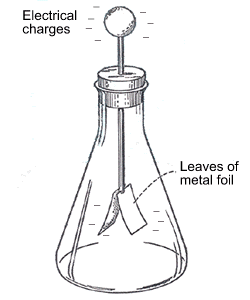The electroscope is a device from detecting electric charge on an object. By using an electroscope, we can tell whether an object is electrically charged or not. We will now describe the construction and working of a simple electroscope
Also Check: Force
From the above discussion we conclude that whether an object is positively charged or negatively charged it will cause the aluminum leaves of the electroscope to diverge when touched with the metal top of the electroscope. Please note that greater the amount of electric charge on an object, greater the aluminum leaves will diverge. If, however, an object is uncharged (having no electric charge) then the aluminum leaves will not diverge at all.

Detection of Charge with Electroscope
We will now describe how the charge on an object can be detected by using an electroscope. In order to detect the electric charge on an object, we touch the metal top of the electroscope with that object and observe the aluminum leaves:
If on touching the metal top of electroscope with the given object, the aluminum leaves of the electroscope diverge (or open up), then the given object has an electric charge on it (or the given object is electrically charged).
Also Check: Frictional Force
If on touching the metal top of electroscope with the given object, the aluminum leaves of the electroscope do not diverge (do not open up), then the given object has no electric charge on it for the given object is electrically uncharged).
Earthing of a Charged Electroscope
When an electroscope is charged, its aluminum leaves are diverged. If we touch the metal top of a charged electroscope with our finger, it gets discharged and thus aluminum leaves collapse (or fold up).Actually, when we touch the metal top of a charged electroscope with our finger, then the electric charge present on charged electroscope flows to the earth through our hand and body.
The electroscope loses all the electric charge, becomes uncharged and hence its diverged aluminum leaves collapse (or told up). The process in which the metal top of a charged electroscope is touched with finger and its charge flows into earth through our hand and body is called earthing. In general we can say that: The process of transferring an electric charge from a charged object to the earth is called earthing. Earthing can also be done by connecting the metal top of the charged electroscope to the earth directly by means of a metal wire (called earth wire). In that case the electric charge of electroscope will flow to the earth through the metal wire.
Also Check: Waves
The electric current in the wiring of houses and other buildings is due to the flow of electric charges(called elections) through them. Earthing is provided in the wiring of houses and other buildings to protect us from electric shocks which may occur due to any leakage of electric current from the body of an electrical appliance. Metal wires (called earth wires) arc used for this purpose.
Electric Discharge: Production of Sparks
Air is a non-conductor of electricity. So, normally air does not conduct electric charges (or electric current). If, however, the amount of electric charges on two oppositely charged surfaces is very large, then the air between them conducts electricity in the form of a spark (a spark is a flash of light which is seen for a very short time). Actually, the electric energy heats the air to such a high temperature that it glows. This glow of air is seen as a spark or flash. Thus, if the amount of opposite electric charges on two surfaces is very large, the insulation of air between them breaks and it allows electric charges to pass through it.
Also Check: Buoyant Force
The passage of electric current in air due to movement of electric charges is called electric discharge. During electric discharge, the positive and negative electric charges cancel out each other and an electric spark and a crackling sound are produced. In nature, electric discharge within a cloud during thunderstorm produces huge electric sparks known as lightning along with a loud sound called thunder. And electric discharge between a thundercloud and the earth also produces lightning followed by thunder. We will now explain the process of lightning in terms of the production of electric charges by friction in the clouds in the sky followed by electric discharge.
Frequently Asked Questions
An electroscope is a tool that helps identify if an object has an electrical charge.
An electrometer is a device that measures the amount of electrical charge in a precise manner.
The main types of electroscopes include:
- Pith-ball electroscope
- Gold-leaf electroscope
True.
The gold-leaf electroscope was invented by Abraham Bennet in 1787.
Related Links
| S.no | Formulas List |
|---|---|
| 1. | Force |
| 2. | Frictional Force |
| 3. | Thrust and Pressure |
| 4. | Buoyant Force |
| 5. | Waves |
| 6. | Sound |
| 7. | Some Natural Phenomena |
| 8. | Electroscope |
| 9. | Lightning |
| 10. | Earthquake |